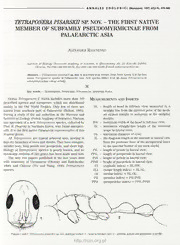
Tetraponera Pisarskii sp. nov. - the first native member of subfamily Pseudomyrmicinae from palearctic Asia PDF
Preview Tetraponera Pisarskii sp. nov. - the first native member of subfamily Pseudomyrmicinae from palearctic Asia
ANNALES ZO O L O G IC I (Warszawa), 1997, 47(3/4): 479-480 TETRAPONERA PISARSKIISP. NOV. - THE FIRST NATIVE MEMBER OF SUBFAMILY PSEUDOMYRMICINAE FROM PALAEARCTIC ASIA Alexander Radchenko Institute of Zoology Ukrainian Academy of Sciences, B. Khmelnitsky str., 15, Kiev-30, 252601, Ukraine, Tel (380+44) 224-83-72, Fax (380+44) 224-15-69, E-mail [email protected] Abstract.— Tetraponera pisarskii sp. nov. is described from worker, from North Korea. It is the first native Tetraponera species in Palaearctic Asia. New species differs from all Asian Tetraponera in ochraceous-yellow colour of body. Key words.— Hymenoptera, Formicidae, Tetraponera, taxonomy, Korea. Genus Tetraponera F. Smith includes more than 100 Measurements and Indices described species and subspecies, which are distributed mainly in the Old World Tropics. Only few of them are HL - length of head in full-face view, measured in a known from southern part of Palaearctic (Bolton, 1995). straight line from the anterior point of the medi During a study of the ant collection in the Museum and an clypeal margin to mid-point of the occipital Institute of Zoology (Polish Academy of Sciences), Warsaw, margin; one specimen of a new Tetraponera species, collected by HW maximum width of the head in full-face view; Prof. B. Pisarski in Northern Korea, was found unexpect SL maximum straight-line length of the antennal edly. It is the first native Palaearctic representative of this scape in lateral view; tropical genus. OL maximum diameter of eyes; All Tetraponera are typical arboreal ants, nesting in AL the diagonal length of the alitrunk in lateral view thin dry branches of trees and shrubs. They have elongate, from the posterior base of the metapleural lobes slender body, long petiole and postpetiole, and short legs. to the anterior border of the neck shield; Biology of Tetraponera species is poorly known, and no PtL length of petiole in lateral view; taxonomic revision of this genus has been made until now. PPtL length of postpetiole in lateral view; The only two papers published in the last years deal PtH height of petiole in lateral view; with taxonomy of Vietnamese (Dlussky and Radchenko, PPtH height of postpetiole in lateral view; 1990) and Chinese (Wu and Wang, 1990) Tetraponera Cl (cephalic index) = HL:HW; species. SLI (scape length index) = HL:SL; 01 (ocular index) = HL:OL; PtI (petiolar index) = PtL:PtH; PPtI (postpetiolar index) = PPtL:PPtH. Figures 1 and 2. Tetraponera pisarskii sp. nov., holotype worker: 1 - head in full-face view; 2 - alitrunk, petiole and postpetiole in profile. http://rcin.org.pl 480 A. Radchenko Tetraponera pisarskii sp. nov. Antennal scapes and legs without hairs. Decumbent pubes cence absent. Material examined. Holotype worker: Korea, Entire body and appendages ochraceous-yellow. Pyongyang, 21.VII. 1959 (leg. B. Pisarski). Comments. T. pisarskii differs from all Asian Deposition of holotype. Museum and Institute of Tetraponera species by yellow colour of the body. Zoology, Polish Academy of Sciences, Warsaw. Biology. Unknown. Measurements. HL=0.66 mm; HW=0.49 mm; SL=0.28 mm; OL = 0.22 mm; AL = 0.91 mm; Ptl = 0.42 mm; Acknowledgements PPtL = 0.27 mm. Diagnosis of worker (see Figs 1 and 2). Head elongate I am very grateful to Dr. W Czechowski, Prof. S. (Cl = 1.38), slightly narrowed anteriorly, with widely round Kazubski and Dr. S. A. Ślipiński. who made the study of the ed ventral corners and somewhat convex occipital margin. ant collection of the Museum and Institute of Zoology, Eyes large (01=2.94), flattened, oval, situated approxi Polish Academy of Sciences possible for me. mately in the middle of lateral sides of head. Ocelli absent. Antennal scapes short (SLI=2.35), funiculus with 5-jointed References club; second to fifth funicular joints obviously transverse, joints of antennal club (except elongate apical one) sub Bolton, B. 1995. A New General Catalogue of the Ants of the World. square. Cambridge-London: Harward University Press, Cambridge, Mesosoma long, promesonotum slightly convex, metan- Mass., London, 504 pp. otal groove deep, propodeum convex, rounded, flattened Dlussky, G.M. and A.G. Radchenko. 1990. [Ants (Hymenoptera, laterally, its horizontal part shorter, than declivity. Formicidae) of Vietnam. Subfamily Pseudomyrmicinae. Subfamily Myrmicinae (Tribes Calyptomyrmecini, Petiolar node long and low (Ptl=2.50), longer than Meranoplini, Cataulacini)]. News of Faunistics and anterior peduncule; postpetiole also low and elongate Systematics. Kiev, Naukova Dumka, pp. 119-125 (in Russian). (PPtI=1.73). Wu, J. and C. Wang. 1990. A Taxonomic Study of the Genus Body smooth and shining. Sparse long curved hairs Tetraponera Smith in China. Scientia Silvae Sinicae, 26: present on occiput, clypeus, pronotum, and gaster. 515-518. Received: Decmber 20, 1996 Corresponding Editor: M. Hołyńska Accepted: May 12, 1997 Issue Editor: D. Iwan http://rcin.org.pl
